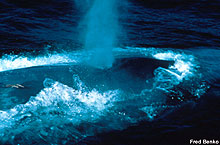 | ||||||||||||
|
|
|
|
|

A small inflatable boat slows to approach the whale, its driver grabbing a long-lens camera. The motor drive whirrs as several photos capture the mottled pattern next to the whale’s dorsal fin. After the whale re-submerges, the researcher retrieves bits of sloughed skin. DNA testing will reveal the whale’s gender which, when coupled with the photos, will provide valuable information about the biology and distribution of this individual whale. Meet John Calambokidis, acknowledged expert on blue whales in the Eastern North Pacific. Co-founder of Cascadia Research, Calambokidis has served as principal investigator on over 40 research studies on marine mammals and seabirds. He has worked for two decades in close partnership with the NOAA National Marine Sanctuary Program, especially the West Coast and Hawaiian Island national marine sanctuaries. Since 1986, Calambokidis has led a study of blues and humpbacks off California and south to Central America. In the last century, commercial whalers worldwide hunted blue whales with such ruthless efficiency, it was thought that extinction of the species – at 100 feet long, the largest animal ever to live on the planet – was inevitable. Whaling continued off California as recently as 1966, with the closure of San Francisco Bay whaling stations. By then little was known of these remnant populations, but reports of blue whale sightings from the Gulf of the Farallones off San Francisco were tantalizing. Starting in 1986, Gulf of the Farallones National Marine Sanctuary funded the first three years of what would become a decades-long study of the whales. In 1988, while conducting aerial surveys over the Gulf of the Farallones, Calambokidis found an astounding concentration of over 100 blues. He knew he was on to something big. Over the years Calambokidis expanded this study to southern California and Central America, finding other concentrations in Monterey Bay, the Santa Barbara Channel, Baja and Costa Rica. He and his colleagues, including wife and co-researcher Gretchen Steiger, gained data on the whales’ abundance, population structure and trends, distribution and habitat use—information essential to their conservation. Now, Calmbokidis puts the total of blues off California and Mexico at about 2,000 – the largest stock remaining on the planet. “It is no coincidence that the only recovering population of blue whales on Earth targets the waters of the California national marine sanctuaries as their feeding grounds,” he told a group of fellow researchers. Due to protection from hunting, and the preservation of critical habitats, Calambokidis is cautiously optimistic that, although their numbers remain low, the endangered blue whale is no longer at imminent risk of extinction. To learn more about blue whales, check out the Channel Islands and Cordell Bank entries in our Encyclopedia of the Sanctuaries.
|

|
|
||||||
|
||||||||||||





